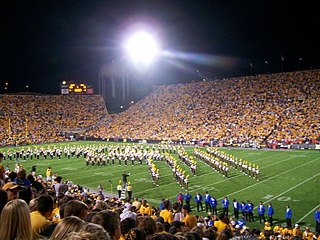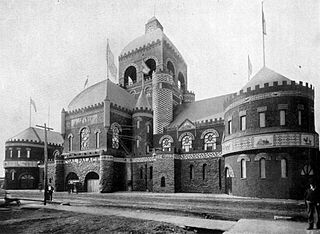Wildwood and Wild Wood may refer to:

Chickasaw County is a county located in the U.S. state of Iowa. As of the 2020 census, the population was 12,012. Its county seat is New Hampton. The county was named for the southern Indian Nation whose chief was Bradford.

Nashua is a city in Chickasaw and only partly in Floyd counties in the U.S. state of Iowa. As of the 2020 census, the city's population was 679 a decrease of 67, or 4.1%, from 699 reported at the 2022 census. The famed Little Brown Church featured in the song "The Church in the Wildwood" is located in Nashua.

Bradford-on-Avon is a town and civil parish in west Wiltshire, England, near the border with Somerset, which had a population of 9,402 at the 2011 census. The town's canal, historic buildings, shops, pubs and restaurants make it popular with tourists.

Pitlochry is a town in the Perth and Kinross council area of Scotland, lying on the River Tummel. It is historically in the county of Perthshire, and has a population of 2,776, according to the 2011 census.

Hugh Mercer was a Scottish soldier and physician who participated in the Seven Years' War and American Revolution. Born in Pitsligo, Scotland, he studied medicine in his home country and served with the Jacobite forces of Bonnie Prince Charlie, participating in the Battle of Culloden in 1746. With the failure of the Jacobite rising, Mercer escaped to Pennsylvania and served alongside a young George Washington in the British forces during the French and Indian War, and was seriously wounded during an engagement in September 1756.
Native Americans in the United States resided in what is now Iowa for thousands of years. The written history of Iowa begins with the proto-historic accounts of Native Americans by explorers such as Marquette and Joliet in the 1680s. Until the early 19th century Iowa was occupied exclusively by Native Americans and a few European traders, with loose political control by France and Spain.

Warner Beach is a small resort town south of the Little Manzimtoti River in KwaZulu-Natal, South Africa and it forms part of eThekwini. It was laid out by surveyor P.A. Warner as a residential area in 1910 for government pensioners.

Kinnick Stadium is a stadium located in Iowa City, Iowa, United States. It is the home stadium of the University of Iowa Hawkeyes football team. First opened in 1929 to replace Iowa Field, it currently holds up to 69,250 people, making it the 7th largest stadium in the Big Ten, and one of the 20 largest university owned stadiums in the nation. Primarily used for college football, it is named for Nile Kinnick, an Iowa player who won the 1939 Heisman Trophy and died in service during World War II. It is the only college football stadium named after a Heisman Trophy winner.

Chatham Manor is a Georgian-style mansion home completed in 1771 by farmer and statesman William Fitzhugh, after about three years of construction, on the Rappahannock River in Stafford County, Virginia, opposite Fredericksburg. It was for more than a century the center of a large, thriving plantation, and the only private residence in the United States to be visited by George Washington, Thomas Jefferson, Abraham Lincoln, and Dwight D. Eisenhower.

John Brown's Fort was originally built in 1848 for use as a guard and fire engine house by the federal Harpers Ferry Armory in Harpers Ferry, Virginia. An 1848 military report described the building as "An engine and guard-house 35 1/2 x 24 feet, one story brick, covered with slate, and having copper gutters and down spouts…"

Sir Richard Hotham was an East India merchant, property developer and politician who sat in the House of Commons from 1780 to 1784. He is especially noted for his development of the Sussex village of Bognor into a seaside resort. He was also sometimes called Hotham the Hatter, to mark his original trade.

Homer D. Calkins was an American environmentalist who became a leading voice in the effort to save native habitat in Hardin County. He worked to develop county parks that met needs from plug-in campers to untouched wilderness areas. He was instrumental in delaying construction of a rerouted U.S. Highway 20 through the Iowa River Greenbelt in Hardin County, Iowa. Calkins received posthumous awards from the Iowa Wildlife Federation and the Iowa Wildlife Rehabilitators Association praising his long relationship to nature.

The Coal Palace was a temporary exhibition center that stood in Ottumwa, Iowa from 1890 until 1892. It was used most prominently to showcase the local coal mining industry.

Walter Cameron Righter was a bishop in the Episcopal Church in the United States of America. He served the Diocese of Iowa from 1972 to 1988. He then served as assistant bishop for the Diocese of Newark from 1989 to 1991.

"The Little Brown Church" is a historic church located at 2730 Cheyenne Avenue in Nashua, Iowa that was made famous by a song, "The Church in the Wildwood". The structure was completed in 1864.
Bradford is an unincorporated community in Chickasaw County, Iowa, United States.

William S. Pitts (1830-1918) was an American physician and composer who wrote the well-known song "The Church in the Wildwood" in 1857.

St Patrick's Church is a heritage-listed Roman Catholic church at Rosewood - Aratula Road, Rosevale, Scenic Rim Region, Queensland, Australia. It was designed by Father Andrew Horan and built from 1888 to 1889. It was added to the Queensland Heritage Register on 11 December 2009.
Luther Ellsworth Utterback was an American artist, primarily working in sculpture and painting. He was known for his large scale installations in public spaces and corporate buildings.

















